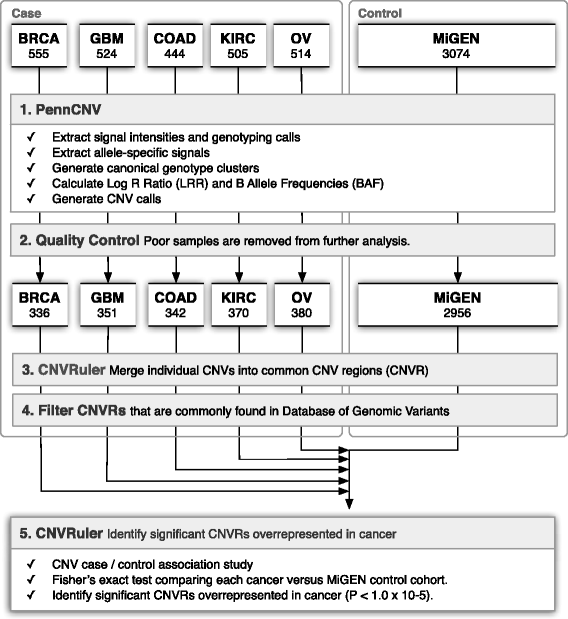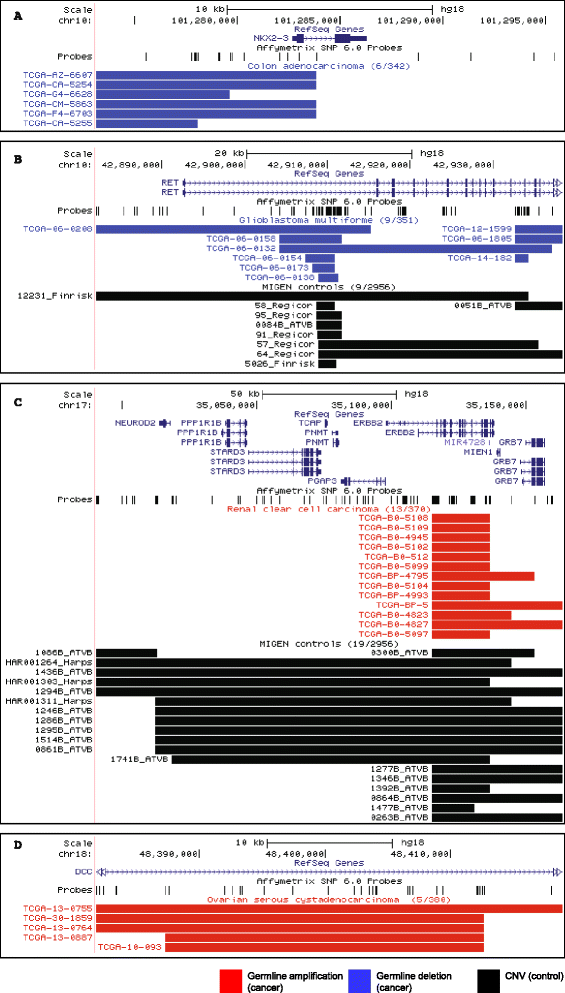Identification of rare germline copy number variations over-represented in five human cancer types
- PMID: 25644941
- PMCID: PMC4381456
- DOI: 10.1186/s12943-015-0292-6
Identification of rare germline copy number variations over-represented in five human cancer types
Abstract
Background: Copy number variations (CNVs) are increasingly recognized as significant disease susceptibility markers in many complex disorders including cancer. The availability of a large number of chromosomal copy number profiles in both malignant and normal tissues in cancer patients presents an opportunity to characterize not only somatic alterations but also germline CNVs, which may confer increased risk for cancer.
Results: We explored the germline CNVs in five cancer cohorts from the Cancer Genome Atlas (TCGA) consisting of 351 brain, 336 breast, 342 colorectal, 370 renal, and 314 ovarian cancers, genotyped on Affymetrix SNP6.0 arrays. Comparing these to ~3000 normal controls from another study, our case-control association study revealed 39 genomic loci (9 brain, 3 breast, 4 colorectal, 11 renal, and 12 ovarian cancers) as potential candidates of tumor susceptibility loci. Many of these loci are new and in some cases are associated with a substantial increase in disease risk. The majority of the observed loci do not overlap with coding sequences; however, several observed genomic loci overlap with known cancer genes including RET in brain cancers, ERBB2 in renal cell carcinomas, and DCC in ovarian cancers, all of which have not been previously associated with germline changes in cancer.
Conclusions: This large-scale genome-wide association study for CNVs across multiple cancer types identified several novel rare germline CNVs as cancer predisposing genomic loci. These loci can potentially serve as clinically useful markers conferring increased cancer risk.
Figures


Similar articles
-
Contribution of rare germline copy number variations and common susceptibility loci in Lynch syndrome patients negative for mutations in the mismatch repair genes.Int J Cancer. 2016 Apr 15;138(8):1928-35. doi: 10.1002/ijc.29948. Epub 2015 Dec 28. Int J Cancer. 2016. PMID: 26620301
-
Genome-wide copy number analysis reveals candidate gene loci that confer susceptibility to high-grade prostate cancer.Urol Oncol. 2017 Sep;35(9):545.e1-545.e11. doi: 10.1016/j.urolonc.2017.04.017. Epub 2017 May 17. Urol Oncol. 2017. PMID: 28527622
-
Germline copy number variations are associated with breast cancer risk and prognosis.Sci Rep. 2017 Nov 7;7(1):14621. doi: 10.1038/s41598-017-14799-7. Sci Rep. 2017. PMID: 29116104 Free PMC article.
-
Implications of germline copy-number variations in psychiatric disorders: review of large-scale genetic studies.J Hum Genet. 2021 Jan;66(1):25-37. doi: 10.1038/s10038-020-00838-1. Epub 2020 Sep 21. J Hum Genet. 2021. PMID: 32958875 Review.
-
Clinical significance of germline copy number variation in susceptibility of human diseases.J Genet Genomics. 2018 Jan 20;45(1):3-12. doi: 10.1016/j.jgg.2018.01.001. Epub 2018 Jan 5. J Genet Genomics. 2018. PMID: 29396143 Review.
Cited by
-
Integrative analysis of genomic and epigenetic regulation of endometrial cancer.Aging (Albany NY). 2020 May 15;12(10):9260-9274. doi: 10.18632/aging.103202. Epub 2020 May 15. Aging (Albany NY). 2020. PMID: 32412912 Free PMC article.
-
Genetic susceptibility to neuroblastoma: current knowledge and future directions.Cell Tissue Res. 2018 May;372(2):287-307. doi: 10.1007/s00441-018-2820-3. Epub 2018 Mar 27. Cell Tissue Res. 2018. PMID: 29589100 Free PMC article. Review.
-
Copy Number Variations in Pancreatic Cancer: From Biological Significance to Clinical Utility.Int J Mol Sci. 2023 Dec 27;25(1):391. doi: 10.3390/ijms25010391. Int J Mol Sci. 2023. PMID: 38203561 Free PMC article. Review.
-
Insights into the Clinical, Biological and Therapeutic Impact of Copy Number Alteration in Cancer.Int J Mol Sci. 2024 Jun 21;25(13):6815. doi: 10.3390/ijms25136815. Int J Mol Sci. 2024. PMID: 38999925 Free PMC article. Review.
-
Identifying disease-associated copy number variations by a doubly penalized regression model.Biometrics. 2018 Dec;74(4):1341-1350. doi: 10.1111/biom.12920. Epub 2018 Jun 12. Biometrics. 2018. PMID: 29894562 Free PMC article.
References
Publication types
MeSH terms
Grants and funding
LinkOut - more resources
Full Text Sources
Other Literature Sources
Research Materials
Miscellaneous

